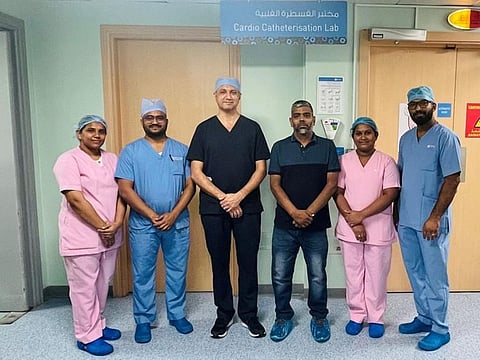Hospital in Abu Dhabi saves leg of Sri Lankan expat who developed massive arterial blood clot
IT executive felt searing pain the day he was discharged after recovering from COVID-19

Also In This Package
Abu Dhabi: A Sri Lankan IT executive in Abu Dhabi who had just recovered from COVID-19 nearly lost his right leg to a giant blood clot.
However, timely diagnosis and treatment at NMC Specialty Hospital in Abu Dhabi helped save Abdul Samad Mohammad Shaliheen’s leg from amputation.
Dr Sanjay Rajdev, consultant interventional cardiologist at NMC Specialty Hospital, who treated the 41-year-old expat said the patient had been discharged from Mussaffah Field Hospital on September 17 after he recovered from COVID-19.
However, the same day, he developed a searing pain in his right leg.
‘Very dangerous situation’
Shaliheen told Gulf News: “The pain was so severe and my leg felt very heavy. Therefore, I decided to go into the emergency right away at the hospital. They did all the diagnostic screenings and I left the hospital after taking painkillers. However, in a few hours the hospital called me and readmitted me to the ICU as they said tests had revealed that I had right leg ischemia or severe occlusion of the whole aorta supplying fresh oxygenated blood to that limb. The lack of blood supply was very dangerous.”
One of the serious post-COVID-19 complications in some rare cases is the threat of pulmonary thrombosis or clot formations. Shaliheen, who does not smoke or drink, is a diabetic and Dr Rajdev said this complication very likely could be attributed as a complication of Type II diabetes.
‘Biggest clot I’ve seen’
Speaking to Gulf News, Dr Rajdev, said: “This is the biggest arterial clot I have seen in my career, measuring 1cm in diameter and nearly 1.5ft in length – so big that we had to an aspiration thrombectomy twice, spread over three weeks, to clear it out completely.”
He added: “The patient’s right limb was cold and had no pulse. Had we waited for any more, the patient’s leg could have developed gangrene, he could have got sepsis in his body and this would not have resulted in limb amputation but also posed a threat to his life. We wasted no time and conducted an Aspiration Thrombectomy using a tool that works like a vacuum cleaner that works on suction principle to absorb the clot and bust it.”
Stubborn clot
Since the first clot was very big, the doctor had to repeat the procedure after three weeks, on October 18, to make sure he was able to bust the smallest parts of the clot, which had begun to create an occlusion again a little lower in the same limb.
“The patient was put on blood thinners and we were closely observing him. We asked him to come again after three weeks and sure enough, we found smaller pieces of the clot piling up again. We had to repeat the aspiration thrombectomy again, though the second time it was a smaller clot to bust. The patient experienced immediate relief and has been well on the path to recovery.”
Quick recovery
Shaliheen told Gulf News: “I have regained nearly 90 per cent of the normal movement in the affected limb after treatment. My pain has also subsided and I have resumed work. I am relieved I rushed to the hospital in time and did not ignore the leg pain. I look forward to complete recovery and will be careful in the future.”
Don’t ignore leg pain
Consult a doctor if you have any of the following symptoms:
* Buttock pain.
* Numbness, tingling, or weakness in the legs.
* Burning or aching pain in the feet or toes while resting.
* A sore on a leg or a foot that will not heal.
* One or both legs or feet feeling cold or changing colour (pale, bluish, dark reddish)
Sign up for the Daily Briefing
Get the latest news and updates straight to your inbox








